Edenbridge
The Redhill to Tonbridge line had for long led a quiet life. It became a secondary and undoubtedly circuitous route from London early on in its existence, after the full opening of the Tonbridge cut-off line via Orpington and Sevenoaks (Tubs Hill) on 1st May 1868. This explains why the route was excluded from the Kent Coast Electrification Scheme and retained mechanical signalling beyond 1962. Sadly, however, this did not protect stations from severe rationalisation, and destruction of much historic SER architecture ensued. Rationalisation at Edenbridge began with the closure of the goods yard on 10th September 1962, but a siding on the "up" side of the line, east of this platform, remained in use for engineers’ traffic. Having avoided electrification, the route retained steam traction beyond June 1962, when the full accelerated electric timetable came into effect on the ex-SER trunk line via Sevenoaks, Tonbridge, and Ashford. Steam-hauled services between Redhill and Tonbridge continued until January 1965, after which diesel electric multiple units filled the breach in the third rail network.
Modernisation at Edenbridge began in Spring 1971, with the installation of new electric platform lighting. In June of the same year, destruction of all platform structures began, as the station embarked on a new Spartan, barren existence. The "down" platform was considerably shortened at its eastern end, and became host to a basic brick-built rectangular-shaped waiting shelter, measuring about 30-feet in length by 12-feet in width. In turn, the "up" platform was equipped with a single rectangular glazed bus shelter, which left the SER signal box as the oldest structure on site. The latter itself was abolished on 31st May 1986, when colour light signals were introduced on the route, controlled from Three Bridges and Tonbridge Power boxes. The station retained the quintessential SER feature of a track foot crossing between staggered platforms – for now.
In Spring 1990, the Government approved the electrification of the Redhill to Tonbridge line at a cost of £19 million. This formed part of an £80 million allocated budget to British Rail for Channel Tunnel freight services, which included the procurement of Class 92 dual-electric locomotives. Work began within the year, and as part of the scheme, the track foot crossing at Edenbridge was abolished, being replaced by a footbridge as equally austere as the 1971 waiting accommodation. Always the poor relation of the much more grand Town station of the LB&SCR, today Edenbridge is a decidedly depressing arrangement. Like so many stations within the confines of the South Eastern Division, rationalisation and modernisation has transformed the site into a bleak affair, an atmosphere compounded in recent years by the installation of palisade fencing. Sadly, no tongue-and-groove timber buildings to the original SER design remain on the line between Redhill and Ashford, the majority having been obliterated over a two-decade period from about 1970 onwards. Even the SER clapboard design at Pluckley is a later fabrication, having replaced its tongue-and-groove predecessor circa 1885.
As of 1993, after the electrification works, Edenbridge retained three ground levers: Ground Frames A, B, and C. Ground Frame "A" controlled a trailing crossover between the running lines, at the eastern end of the station; Ground Frame "B" controlled the remaining "up" side engineers' siding; finally, Ground Frame "C" operated a trailing crossover between the running lines at the western end of the station. Rationalisation of this layout began in November 2006, with the abolition of the eastern crossover and Ground Frame "A". This was followed on 26th February 2007 with the formal removal of the "up" siding and Ground Frame "B". Ground Frame C remains in existence, as does the western crossover, thus providing a facility which still allows trains to reverse at the station.
Signalling: By Peter Gibbons
Ground Frame "B" used to control the access to the the "up" siding opposite the "down" platform, now lifted as one of the pictures shows. When Edenbridge Signal Box was in use it was known as Ground Frame "A", just to confuse the issue further! When colour light signalling was installed, Ground Frame "A" and Ground Frame "B" (which in the days of Edenbridge Signal box controlled the crossover at the eastern end of the "down" platform) were transposed to become Ground Frame "B" and Ground Frame "A" respectively.
Ground Frame "C" is not a lever frame at all but is in actual fact a locked switch cabinet off the western end of the "up" platform by about 50 yards. This is the only ground frame that is in use and controls the one remaining crossover at Edenbridge. It is electrically released from Ashford IECC when required for use. The crossover points are motorised and can only be controlled by the ground frame.
The signal box stood at the foot of the "up" platform at the western (Godstone) end. The crossover now controlled from Ground Frame "C" was originally mechanically worked directly from the signal box and was fully equipped with shunt signals, something it totally lacks today.
1982
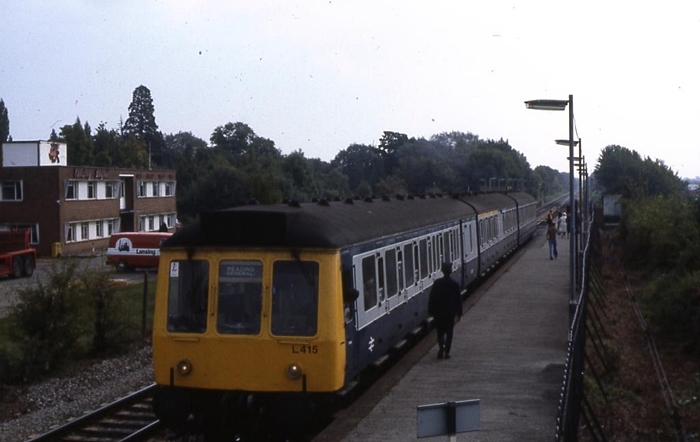
Compared with today, this view depicts a decidedly rural scene. Alongside the "up" platform is Class 117 No. L415, forming a Tonbridge to Reading General service. The site of the factory, on the left-hand side of this view, has very recently given way to high density housing. Indeed, a track foot crossing remained in use here for a further eight years. © Peter Gibbons
1982
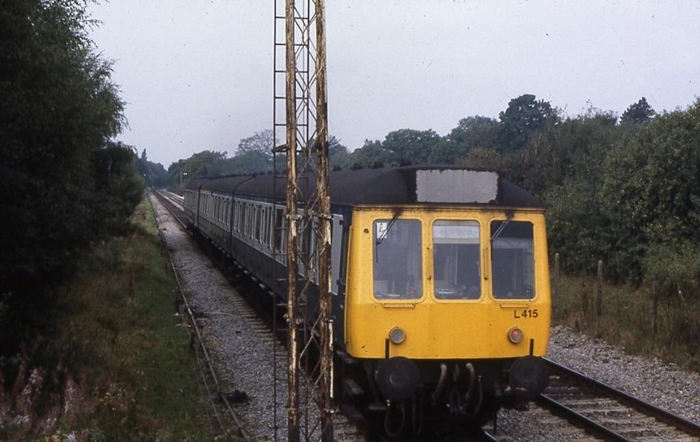
A view from the signal box shows No. L415 departing the station: next stop Godstone. Beside the unit, to the left, can be seen the cables linking the signal cabin with the semaphore signals in the distance. Also in view, alongside the unit, is the point rodding which leads to the only crossover worked by the signal box (now Ground Frame "C"). The front coach of the train marks the approximate position of the crossover. © Peter Gibbons
1982
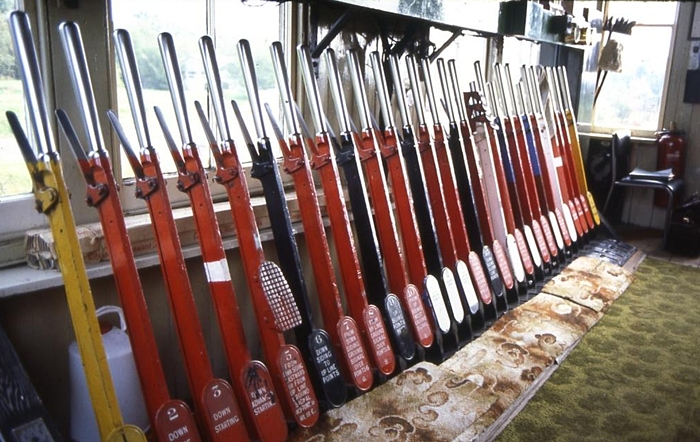
This view depicts a splendid formation of 28-levers within the SER signal box. Peter notes that there are a number of levers that appear to be in use, but are in fact abolished. The only levers still in use at that time were 1, 2, 3, 4, 11, 12, 13, 19, 22, 25, 26, 27 and 28. All other levers, red and black, were redundant, but the interlocking was still in place, hence the reason as to why they retained their original colours. Such levers were bolted so that they could not be moved by the signalman inadvertently. © Peter Gibbons
1982
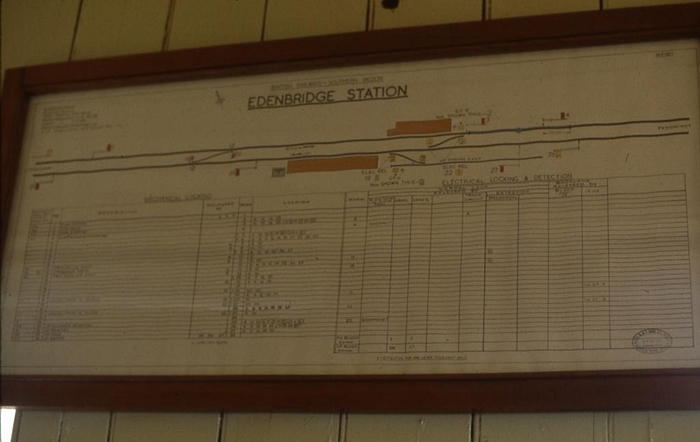
Edenbridge station signalling diagram, seen within the SER cabin, showing locations of crossovers and the remaining siding. © Peter Gibbons
1982
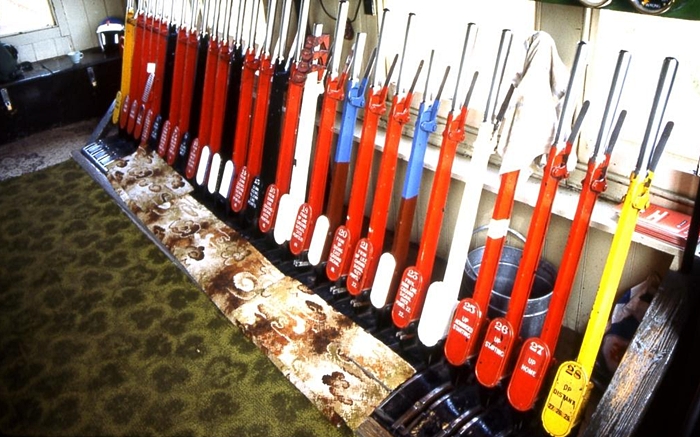
Red levers controlled "stop" signals, yellow levers controlled "distant" signals, and black levers were assigned to points. © Peter Gibbons
Return to the Kent Rail Homepage or alternatively, check for Updates.
Website & Copyright information - Links - Contact the Webmaster

